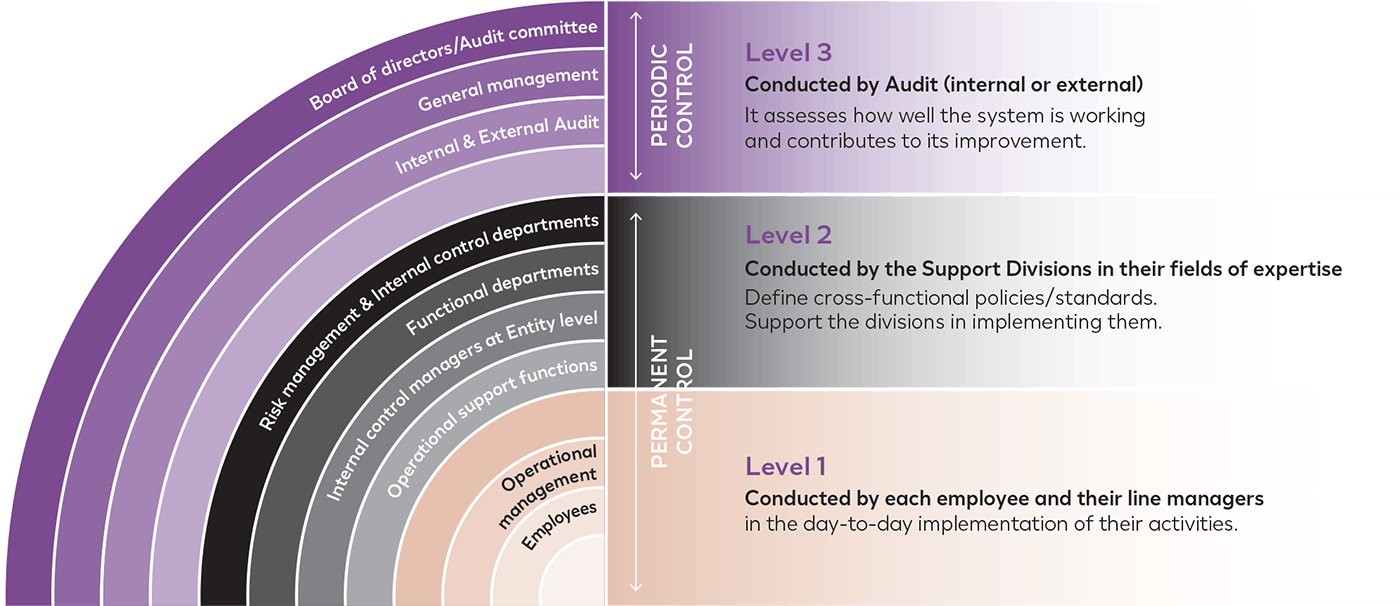3. Risk factors and risk management
3.2 Components of the Internal Control and Risk Management systemThe network of Internal Control managers continued to be built up worldwide through:
- compulsory learning for new Internal Control managers;
- learning courses specific to each business segment to present the risks and the associated control framework;
- informative webchats for sharing updates on Group projects and business standards; and
- a network of Zone Internal Control managers and Internal Control officers in each business segment.

This diagram indicates the network of the internal control managers continued to be built worldwide.
Permanent control
Level 1
- Conducted by each employee and their line managers in the day-to-day implementation of their activities.
- Operational management
- Employees
Level 2
- Conducted by the Support Divisions in their fields of expertise Define cross-functional policies/standards. Support the divisions in implementing them.
- Risk Management and Internal Control Departments
- Functional departments
- Internal Control Managers at Entity level
- Operational support functions
Periodic control
Level 3
- Conducted by Audit (internal or external) It assesses how well the system is working and contributes to its improvement.
- Board of Directors / Audit Committee
- General management
- Internal and External Audit
3.2. Components of the Internal Control and Risk Management system
3.2.1. Organisation and environment
The control environment is critical to the Internal Control system. It ensures to properly manage the risks and implement procedures. It is based on behaviours, the organisational structure and employees. At L’Oréal, it forms part of a culture of rigour and commitment communicated by senior management in line with the Group’s strategic choices.
The Group’s Ethical Principles
L’Oréal’s development and reputation are built on strong Ethical Principles: Integrity, Respect, Courage and Transparency. The Group’s policies on sustainability, social and societal responsibility, compliance and philanthropy are based on the Ethical Principles.
L’Oréal’s Code of Ethics is available in 30 languages and as an audiobook in English and French. In 2023, it was completely overhauled. It is distributed to all employees around the world. It uses simple rules and concrete examples to explain how they can apply these Ethical Principles in their behaviours and actions.
The Code of Ethics applies to all employees, directors and corporate officers and members of the Executive and Management Committees.
The Chief Ethics, Risk and Compliance Officer
The Chief Ethics, Risk and Compliance Officer reports directly to the Chief Executive Officer and keeps him informed on a regular basis. The Chief Ethics, Risk and Compliance Officer regularly informs the Board of Directors and the Executive Committee. His mission on Ethics is to:
- promote and integrate best practices within the Group, by facilitating ethical decision-making;
- oversee employee learning;
- oversee the management of alerts and directly manage those related to senior management positions; and
- measure and assess the Company’s ethical performance.
They have a dedicated budget and team, and unrestricted access to all information about the Group’s business activities. They can call upon any of the Group’s teams and resources in the performance of their work.
